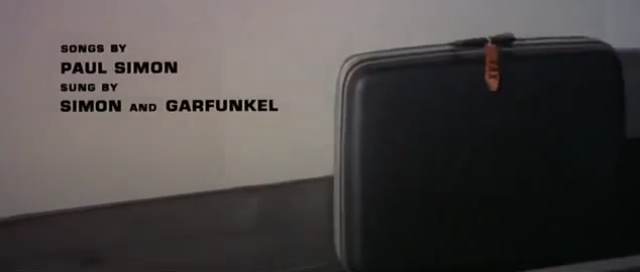The Graduate has a ton of interesting cinematography. We already talked about a good amount of it in class such as with the aquarium or the scuba diving scene or the claustrophobic conversations Ben has with family friends at the beginning of the film. I wanted to look at some of the clever shots we did not get to discuss in class.
One thing I always liked about the opening shot with Ben on a conveyor belt is the fact that he moves from the right side of the screen to the left. We already associate moving to the right as progress, and it feels more natural to us as we also read from left to right. There have also been psychological studies in film that show that we associate more positive emotions with people moving from left to right in a shot. So Ben being carried leftward at the start of the film indicates that he is not progressing, and it adds to the sense of dread we feel. It also seems purposeful that Ben is on a conveyor belt as he gives up control while on it. He is carried in a certain direction by an external force, and this is the current condition of his life. There is some parallelism with the shot that follows as we see his suitcase on a conveyor belt moving in the same direction:

This editing seems to say that Ben has as much free will as his suitcase on the conveyor belt.
I also wanted to mention the sun glare shot. After the montage showing the progress of Ben and Mrs. Robinson’s relationship, Ben is lying on a raft in the pool, and his dad starts lecturing him that he needs to do something with his life. We can barely make out his dad’s face because of the sun beating down on the camera:

This is just another of many shots that illustrates the dynamic among Ben and his parents. They are blinding and suffocating, constantly looking down and beating down, like the sun in this shot.
Speaking of the sun, I wanted to briefly mention the motif of tans I noticed in this film. It seems every single character has a tan. In the same scene with the sun, we see how much color Ben’s back has. And by the midpoint of the film, we are pretty familiar with Mrs. Robinson’s tan lines. These tans seem to be another artifact of the cloying life that Ben has become disillusioned to. They indicate a social pressure for good looks and the presence of leisure in the middle class life, as everyone seems to have the free time to lay down and get a tan.
The last cinematographic technique I wanted to point out is the use of dramatic zoom such as in this shot of Mrs. Robinson, if you remember:

Right after Ben comes out of Elaine’s room, we have a closeup of Mrs. Robinson’s face, and then it zooms out into this shot. It reminds me of the zooms in Kubrick’s filmography. From what I have seen, I think many filmmakers do not utilize these zooms because they are very dramatic and call attention to themselves. I don’t know why, but I love these zooms. I think it may be because it makes the moment feel very important. When these zooms are used effectively, it is never in a shot with action. It is during a quiet moment with no movement. Something serious just happened, and this is the moment of realization. I think it is the stillness of such a grave moment, combined with the camera movement which builds intensity, that makes this technique so immersive for me.
